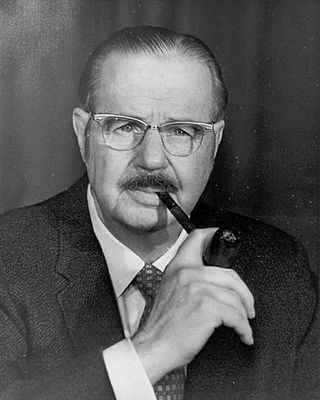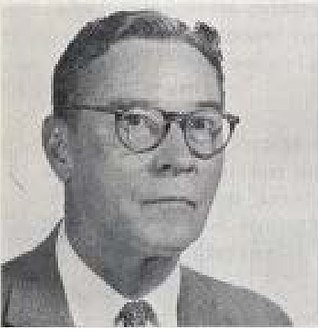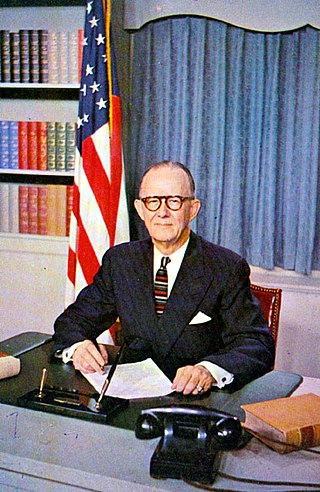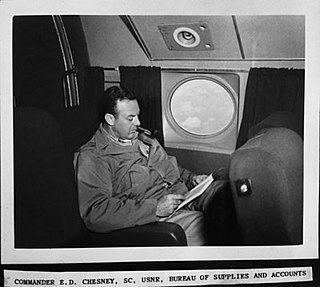
Dwight David Eisenhower, nicknamed Ike, was an American military officer and statesman who served as the 34th president of the United States from 1953 to 1961. During World War II, he was Supreme Commander of the Allied Expeditionary Force in Europe and achieved the five-star rank as General of the Army. Eisenhower planned and supervised two of the most consequential military campaigns of World War II: Operation Torch in the North Africa campaign in 1942–1943 and the invasion of Normandy in 1944.

The Executive Office of the President of the United States (EOP) comprises the offices and agencies that support the work of the president at the center of the executive branch of the United States federal government. The office consists of several offices and agencies, such as the White House Office, the National Security Council, and the Office of Management and Budget.

William Pierce Rogers was an American politician, diplomat, and attorney. A member of the Republican Party, Rogers served as the 4th Deputy Attorney-General of the United States (1953–1957) and as the 63rd Attorney-General of the United States (1957–1961) in the administration of Dwight D. Eisenhower, and as the 55th Secretary of State (1969–1973) in the administration of Richard Nixon.

Hugh Doggett Scott Jr. was an American politician. A member of the Republican Party, he represented Pennsylvania in the U.S. House of Representatives from 1941 to 1945 and from 1947 to 1959 and in the U.S. Senate, from 1959 to 1977. He served as Senate Minority Leader from 1969 to 1977.

Dillon Anderson was an official in the federal government of the United States during the Eisenhower administration (1953–61). He served as the 2nd National Security Advisor from April 2, 1955, to September 1, 1956. He also was a member of the Draper Committee.

Lawrence Brooks Hays was an American lawyer and politician who served eight terms as a Democratic member of the United States House of Representatives from the State of Arkansas from 1943 to 1959. He was also a president of the Southern Baptist Convention.

James Rhyne Killian Jr. was the 10th president of the Massachusetts Institute of Technology, from 1948 until 1959.

The Dwight D. Eisenhower Memorial is a United States presidential memorial in Washington, D.C. honoring Dwight David Eisenhower, the Supreme Commander of the Allied Forces in Europe during World War II and the 34th President of the United States.

Dwight D. Eisenhower's tenure as the 34th president of the United States began with his first inauguration on January 20, 1953, and ended on January 20, 1961. Eisenhower, a Republican from Kansas, took office following a landslide victory over Democrat Adlai Stevenson in the 1952 presidential election. John F. Kennedy succeeded him after winning the 1960 presidential election.

Cecil Murray Harden was an American educator who became a Republican politician and an advocate of women's rights. She served five terms in the U.S. Representative representing Indiana's 6th congressional district. Harden was the only Republican woman elected to represent Indiana in the U.S. Congress until 2012, when Susan Brooks and Jackie Walorski were elected to serve in the 113th United States Congress beginning in January 2013.
Bertha Sheppard Adkins, was an educator, political activist, public servant, and a community leader.

Earle D. Chesney served with the Veterans Administration before joining the Eisenhower White House staff on March 4, 1954. Prior to his service with the VA, he served as Assistant Usher in the Hoover White House. During World War II and the Korean War he served with the Navy, reaching the rank of captain. During his naval service he became rather famous as the cartoonist who invented the naval character, “Eggburt of the Navy,” who, like the Army's “Sad Sack,” entertained service men and women around the world.
Laurin Luther Henry is an American academic. He worked as a researcher, consultant, and educator. He is considered an expert on the subject of United States presidential transitions.
Robert Cunninghan Humphreys was born in Greenville, Ohio. He was a student at Columbia University from 1926 to 1927.

Clyde A. Wheeler was an American congressional relations expert, lobbyist, and member of the White House staff. After leaving the White House staff, he returned to Oklahoma, where he settled in Tulsa and became a lobbyist for Sun Oil Company. He retired from Sun in 1984 and returned to his ranch in his home town of Laverne, Oklahoma. He continued to do part-time work as a consultant for two Washington law firms until 1988. He died in Laverne in 2013.

John Stewart Bragdon, was a major general in the United States Army.

Elmer Boyd Staats was an American public servant whose career from the late 1930s to the early 1980s was primarily associated with the Bureau of the Budget (BOB) and the GAO. Staats was born to Wesley F. and Maude (Goodall) Staats. Staats received his AB from McPherson College in 1935, his MA from the University of Kansas in 1936, and his Ph.D. from the University of Minnesota in 1939.

The White House Office of Intergovernmental Affairs (IGA) is a unit of the White House Office, within the Executive Office of the President. It serves as the primary liaison between the White House and state, county (or county-equivalent), local, and tribal governments. The office focuses on building new and maintaining current relationships with governors, tribal leaders, mayors, state legislators, and county executives. The Office of Intergovernmental Affairs works with federal agencies and departments to ensure appropriate coordination between state, local, and tribal governments and the federal government. The Director of Intergovernmental Affairs at the White House Office for the Biden administration was Julie Chavez Rodriguez until she resigned on May 16, 2023 to become Biden's Campaign Manager for his 2024 reelection bid. The position was vacant for 4 weeks till former Obama adviser Tom Perez stepped into be the new Director on June 12, 2023.

The presidential transition of Richard Nixon began when he won the United States 1968 United States presidential election, becoming the president-elect, and ended when Nixon was inaugurated at noon EST on January 20, 1969. Nixon had become president-elect once the election results became clear on November 6, 1968, the day after the election. This was the first presidential transition to take place following the passage of the Presidential Transition Act of 1963.

The presidential transition of John F. Kennedy began when he won the 1960 United States presidential election, becoming the president-elect of the United States, and ended when Kennedy was inaugurated at noon EST on January 20, 1961.
















